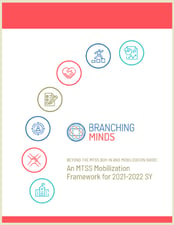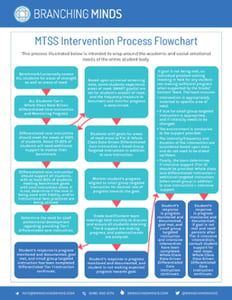Happy New Year! A new semester has begun and with it comes the possibilities for positive change. Getting ready for a new semester is crucial, but it can also be a complicated undertaking, especially with the complexities of a pandemic. As 2022 begins, we wanted to share 22 MTSS resources with you so you can start out the second half of the school year strong and prepared.
There’s something here for everyone: whether you’re a classroom teacher, a school admin, a district leader, or an MTSS coordinator; if you’re exploring what MTSS is; if you’re working on developing an MTSS team, selecting an MTSS tool, aligning your MTSS implementation with the rest of the initiatives at your district, or simply strengthening communication and collaboration.
We’ve divided the resources into MTSS Best Practices, Accelerated Learning, Structure and Leadership in MTSS, and Social-Emotional Learning (SEL). We hope you find them helpful!
MTSS Best Practices
1. Best Practices at Tier 1 For the Secondary Level
This blog discusses best practices at Tier 1 for the secondary level. It defines differentiated Tier 1 instruction and emphasizes the importance of a strong, frequently revised Tier 1 curriculum, differentiated for all learners, and the importance of using interventions as supplemental instruction for struggling learners.
2. Intervention Planning in MTSS: How to Balance Best Practices and Feasibility
While many educators are aware of the issues and limitations of intervention programs, some might find it hard to make the recommended shifts in their MTSS practice given the resources available to them. Funding, staffing, schedules, and remote learning are all factors that can affect a district and school’s ability to implement supports and interventions in line with what we know from research and best practices for MTSS. This blog presents five ways to balance best practices in MTSS with common barriers in education, such as lack of time and resources.
3. MTSS Meetings Guide
This guide provides a breakdown of the three types of MTSS meetings. These three meetings are a school level meeting for school leadership to look at core curriculum health, benchmark growth, tier movement, distribution of resources, and evolution of structures; the grade team or content team community meeting, to create group plans for students who need tier 2 level support, and to check in on progress for all kids who need support; and an individual student support meeting to create individuated plans for students who need tier 3 level support.
4. A Quick Review of MTSS Supports, Interventions, and Accommodations
Terminology can be a pesky obstacle, leading to added frustrations when we can’t find what we need. Between “learning supports,” “interventions,” and “accommodations,” it’s easy to get confused as to what resource is needed during the MTSS cycle. In this blog, we’ve outlined these definitions more in-depth, as well as when/how they’re typically used.
5. Giving Students Agency With a Seat at the MTSS Table
Without student participation at the classroom level, we fail to honor students' ownership of their learning. If students know the targets and can clearly articulate how they plan to reach their goals, they have a higher chance of experiencing success. In this blog, we discuss what specific actions we can take to create a learning culture in our classrooms where students are at the center of the problem-solving process.
6. MTSS Mobilization Framework for 2021-2022 SY
Rolling out MTSS can be daunting. We build step by step, year by year, to develop a clear vision, shared language, and aligned initiatives. We work with our teams to build capacity to understand better and accomplish the work. Let's be honest; the work doesn't always feel feasible. That's why we created this MTSS Mobilization Framework. It provides resources and actions for each key component at all of the 3 "phases"—foundational, developmental, and fully operational—of the implementation journey
7. An MTSS Flowchart: Guiding the Intervention Process
This blog outlines the MTSS intervention processes and it includes a free downloadable flowchart that many teachers and school teams have found helpful. Although the flowchart is universally written and should work in most settings, we understand that each school is unique and has its own language and systems.
Accelerated Learning
8. Selecting the Right Interventions to Boost Accelerated Learning
Research-based interventions provide more targeted and intensive support for students who need extra help mastering grade-level content. Without the combination of data and intervention resources, it’s impossible to deliver differentiated instruction for all student's readiness levels, interests, strengths, and learning preferences required to build up necessary skill sets. This blog analyzes three considerations when choosing appropriate supports for accelerated learning.
9. What’s the Best Way to Address Unfinished Learning? It’s Not Remediation, Study Says
By Sarah Schwartz via Education Week
This article explains the differences between remediation and acceleration, what acceleration means in context, and addresses acceleration as an equity issue.
10. Webinar - Recharging Core Instruction and MTSS
In this free on-demand webinar, we unpack the significance of “recharging” core instruction in an MTSS framework to match accelerated learning needs, especially following such a tumultuous year. We will focus on specific strategies for accelerating learning, reviewing key concepts, and stressing the importance of reframing discussions on “learning loss.”
Structure and Leadership in MTSS
11. A Consensus-Building Strategy for School Leaders
By Victoria Curry via Edutopia
This article goes over the importance of "presenting data as a compelling visual story" and how it "can help school leaders get buy-in from all stakeholders on how to reach important goals."
12. Best Practices for Meetings and How to Apply Them to MTSS
Meetings constitute a large part of our work and an essential part of the work of educators as they come together to make decisions that in most cases impact students’ life and future. School and district teams need to take a systematic approach to run team meetings as in the business world. This blog unpacks meetings, their best practices, and how to apply them in the MTSS context.
13. Communication Planning for MTSS
As districts and schools look to strengthen their MTSS, how school leaders communicate the goals and the evolution of work becomes a forerunner of its acceptance, adoption, and eventual success. This blog provides some steps for a seamless MTSS transition.
14. Developing a Successful MTSS/RTI Team
The MTSS/RTI team is a school-based problem-solving team; it is the engine that drives the MTSS/RTI practice. This blog addresses five questions to consider when developing an MTSS/RTI team.
15. MTSS From Buy-in to Implementation: 8 Steps for Change
By carefully planning for the change of instituting MTSS, districts and schools can ensure that this initiative doesn’t meet the short and sad fate of many before it. Change methods, or change models, are evidence-based approaches to instituting change at an organizational level. In this blog, we outline each step of a change model process as it would align with an MTSS adoption.
16. Leadership During Change and For Continuous Improvement
When organizations engage in frequent program and initiative abandonment, they lessen educators’ degree of agency. It becomes more and more challenging to get critical mass to see and believe in the possibility of beneficial change. This blog addresses key components of implementing change: learning from past initiatives, addressing initiative fatigue, and utilizing support plans.
17. MTSS as Organizing Principle for Moving Beyond the 2020-2021 School Year
To ensure all students can regain ground, we must urgently begin next year with a deep understanding of our student's current areas of academic performance, instruct with a robust core curriculum, provide and monitor data-driven interventions, strengthen attendance, and provide social-emotional support. This blog discusses MTSS as a guiding principle to organize the 2021-2022 school year.
Social-Emotional Learning (SEL)
18. Supporting Schools During and After Crisis
By Center on PBIS (2021) - Positive Behavioral Interventions & Supports [www.pbis.org]
"This page highlights resources to support the use of a multi-tiered systems of support (MTSS) framework to support students, families, and educators during the transitions back to school during and following the global pandemic in a manner that prioritizes their health and safety, social and emotional needs, and behavioral and academic growth."
19. Supporting Teacher SEL and Well-Being within an MTSS Framework
School and district leaders are becoming increasingly dedicated to improving their social-emotional learning (SEL) programs and practices for students. But an area of SEL that sometimes gets overlooked is the social-emotional skills and well-being of staff members. This blog presents four areas of teacher SEL to consider and work towards addressing if you plan on making SEL a priority at your school.
20. The Alphabet Soup of Behavior Support in MTSS
Anyone who works in education knows that teachers, administrators, and other school staff love to use acronyms. But for those new to teaching (as well as parents/guardians/community members), it can be challenging to keep up with the vast amount of different terms. In this blog, we outline the most commonly used acronyms when addressing student behavior within an MTSS framework, break down what they mean, and how to use them effectively.
21. Integrating SEL Into an MTSS Framework: Resolving Four Common Problems
Many educators are familiar with social and emotional learning (SEL) and a Multi-Tiered System of Support (MTSS), but integrating these two frameworks can be challenging. In this blog, we outline four common problems that educators run into when merging these systems and our recommendations for resolving these issues to ultimately strengthen SEL implementation within MTSS.
22. The Power of Strength-Based Instruction
The MTSS framework provides an excellent opportunity for educators to shift their instruction, problem-solving, and planning to include student strengths in addition to areas of needed support. In this blog, we outline the difference between the strengths and deficit lens, how focusing on strengths benefits all key stakeholders in education, and specific guidance on using a strengths-based approach in MTSS.
Let us help you build the right team!Branching Minds offers a variety of professional learning opportunities for states, districts, and schools to ensure instructional leaders, specialists, coaches, and teachers are able to implement RTI/MTSS as well as the BRM platform with fidelity and maximizes educators’ efforts to accelerate learning for all students. |
About the author
Branching Minds
Branching Minds is a highly respected K-12 services and technology company that leverages the learning sciences and technology to help districts effectively personalize learning through enhancements to their MTSS/RTI practice. Having worked with hundreds of districts across the country, we bring deep expertise in learning sciences, data management and analysis, software design, coaching, and collaboration. Combined with our extensive toolkit of resources, PD, and technology, we provide a system-level solution. We are more than a service or a software provider, we are partners who will deliver sustainable results for educators, and a path to success for every learner.

Your MTSS Transformation Starts Here
Enhance your MTSS process. Book a Branching Minds demo today.






















.png?width=716&height=522&name=Understanding%20Literacy%20Basics%20(Preview).png)

.png?width=716&height=522&name=Addressing%20Foundational%20Reading%20Skills%20in%20MTSS%20(preview).png)